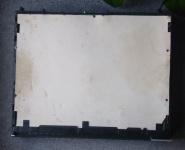Difference between revisions of "Appliance parts"
(substitute) |
(→No part: nm) |
||
| Line 39: | Line 39: | ||
==No part== | ==No part== | ||
Sometimes parts can simply be left out or wired out. The result varies from not a good idea to in some cases a good option. Examples include: | Sometimes parts can simply be left out or wired out. The result varies from not a good idea to in some cases a good option. Examples include: | ||
| − | * Washing machine hot water fill valve, this only affects the boil wash | + | * Washing machine hot water fill valve, this only affects the boil wash. (To use the boil wash, fill on another program then switch to boil wash) |
* a faulty washing machine [[heater]] can be disconnected, and the temp detector wired over | * a faulty washing machine [[heater]] can be disconnected, and the temp detector wired over | ||
* a number of car parts offer only trivial functionality. | * a number of car parts offer only trivial functionality. | ||
Latest revision as of 02:25, 4 September 2017
Ways to get parts:
Original
Original manufacturer (OEM) parts are usually of consistent quality, but often steeply priced. Don't be surprised at £5 for a screw. Often these are required to maintain a warranty. Once out of warranty, the high prices often make repair uneconomic.
Pattern
Unbranded copies are usually much cheaper, and usually ok. But not always.
Other industry suppliers
A few parts can be had cheaper or more conveniently from suppliers to other industries, eg pipes & pipe clips from car accessory shops, aquarium supply shops or industrial hose suppliers.
Refurbished
There are specialist refurbishers who repair and recondition common parts such as printed circuit boards (PCBs) and fans for boilers and PCBs for washing machines. These companies reply upon availability of parts to repair so usually operate on an exchange basis - you buy a refurbished part and return the failed part within a set time. They often offer significant savings over new parts.
Used
Used parts are a very cheap option when you can find them, and can make repairs viable that would otherwise be too expensive. Popular sources include
- freecycle, freegle etc
- online auctions eg ebay
- rubbish dumps, some council tips let people take stuff away
Getting 'spares or repair' items is also a source of parts, especially when you need more than one. Usually you won't get one with the same problem. Depending on the item, disposal of what's left can be by bin, dump, scrap metal merchant, giving it away or sometimes sale.
Used, from a different machine
In some cases parts designed for a different machine can be used. Sometimes its necessary to modify or customise their mounting.
There are some situations where this can potentially be unsafe, such as replacing a fusible resistor with a non-fusible, or a 2kW oven element with a 2.6kW, so some knowledge is required.
Repair
Some parts are repairable, eg motors can be rewound, damaged metal can be epoxied, switch contacts cleaned and so on.
Make it
Some parts are practical to make. Sheet metal & plastic can make many things.
Substitute
Using something else that will do the job. Eg replacing a screwed cordgrip with cable ties, or a bolt with iron wire.
No part
Sometimes parts can simply be left out or wired out. The result varies from not a good idea to in some cases a good option. Examples include:
- Washing machine hot water fill valve, this only affects the boil wash. (To use the boil wash, fill on another program then switch to boil wash)
- a faulty washing machine heater can be disconnected, and the temp detector wired over
- a number of car parts offer only trivial functionality.
